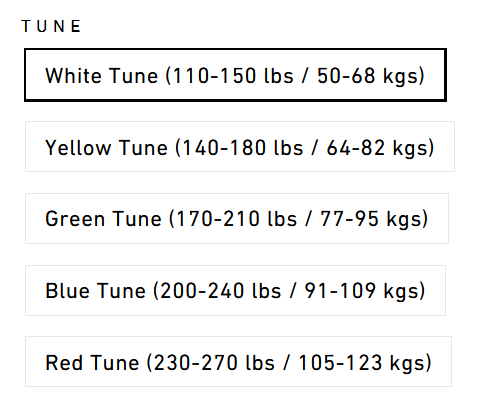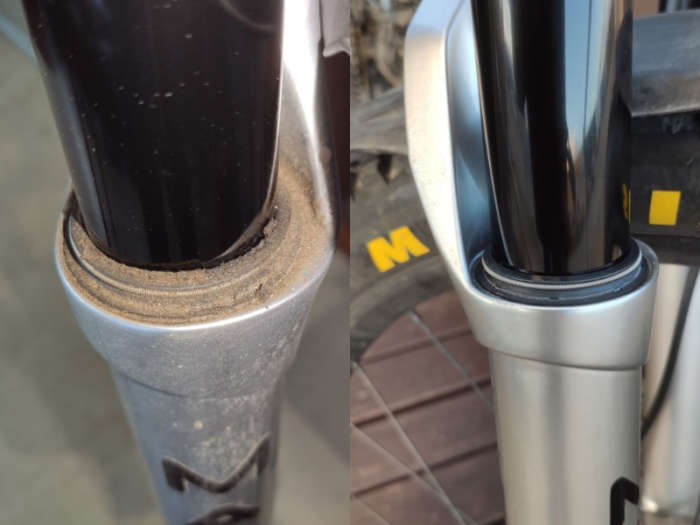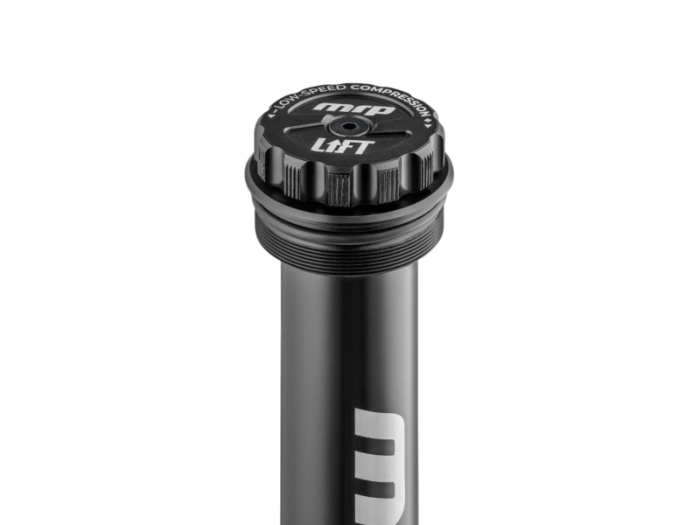MRP Launched their new Lift fork damper in April this year. It's a new direction for a long-standing MTB company. The Lift damper is a self contained damper cartridge made to fit MRP's own forks as well as Rockshox and Fox forks to replace Charger and GRIP dampers.
MRP Lift Tunes & Design
The MRP Lift damper is available with 5 different damping tunes, which MRP grade by rider weight to get "perfectly matched damping".:
 |
| MRP Lift Damper Tune Grades (source MRP website) |
The MRP website says:
Weight-specific shim-stacks provide riders with perfectly matched damping and full usability of the external rebound and compression adjustment ranges. Valving has been optimized to deliver a seamless crossover from the low to high-speed circuits and provide a predictable and responsive terrain-hugging ride. Flow-path optimization and advanced needle shaping have minimized fluid turbulence, yielding quiet operation and superior sensitivity.
Design-wise the Lift is closest to a Fox GRIP damper. It runs a single diameter tube full length, which makes rebound and compression pistons the same diameter. The damper shaft is 10 mm diameter (like basically everything else) and the shaft volume change is handled by a floating piston and spring. This is just like Manitou Intrinsic, Fox GRIP/GRIP2, RS Charger 3 and Ohlins STX/TTX dampers.
The advantage of running a full size rebound piston is reduced manufacturing cost/complexity and damper cushioning. The large amount of oil inside the damper, especially if not vacuum bled, softens small impacts to reduce harshness.
The disadvantage of this design is mid-valve damping can be impossible to keep under control, especially for lighter riders with softer tunes. Cavitation can also be hard to avoid with softer tunes.
MRP has marketing style dyno graphs on their website (see first graph below). These don't show force numbers or adjuster position and range. But they do show the Lift to have a lot more damping than Fox GRIP and the current Rockshox Charger RC.
 |
| Dyno graph comparing the Lift with competitors' dampers (source: MRP website) |
Initial rider reviews were very positive but with a theme of having to reduce spring stiffness. Noah from MRP posted up some extra dyno plots on MTBR for customers who were concerned about mid-valve effects:
 |
| Lift Damper CVP Dyno Plot (source Noah, MRP via MTBR) |
This is a "football" or "CVP" constant velocity dyno plot. It has two curves, one generated with the rebound open (blue) and the other with rebound closed (red). Overlaying the two shows how much effect the rebound (lower half) has on the compression (upper half).
The way these plots overlap shows basically zero midvalve effect. More on that later. The curve bulging to the left is hysteresis caused by the compressibility of the oil and expansion of the damper tube.
Dyno Testing By Shockcraft
I ordered some Lift dampers in May 2024. At 78 kg I was on the overlap between Yellow (second softest) and Green (one step firmer) tunes. I went with Yellow for a Rockshox Lyrik fitment and ordered a selection of other tunes.
Due to availability and distributor order timing the dampers didn't arrive until late August 2024, which was the end of a very cold winter. Trail and weather conditions ranged from icy through freeze/thaw mush to closed. So proper riding time was limited. First thing I did was run the Yellow tune Lyrik Lift on the dyno.
 |
| PVP Dyno - MRP Lift RS35 Yellow Tune vs 2014 RS Charger 1 RC (source: Shockcraft) |
This Yellow tune (second softest MRP make) was almost the firmest modern fork damper I've ever dyno'd. It is only beaten out by the 2014 Rockshox Pike Charger 1 RC (not the same 2024 Charger RC MRP dyno'd). The 2014 Charger 1 RC featured a lockout symbol on the compression dial and everyone rode them wide open!
Recreation of MRP's graph of mid-valve effect (rebound changing compression) on my dyno showed a very different result:
 |
| Lift Damper CVP Dyno Plot with Midvalve Effect (source: Shockcraft) |
Where MRP were showing no midvalve effect I found 29%! This means changing rebound from open to closed makes the compression almost 30% firmer.
Going back to the MRP graph it appears they have two different curves from different dyno calibrations which do not overlay correctly. This leads customers to expect zero interaction between rebound and compression. In reality it is the biggest % change I have found. The RS Charger 2 RCT3 only has 16% midvalve effect.
The midvalve effect like this is not unexpected on this type of damper. Using a full diameter rebound piston means that piston needs to bypass a lot of oil on compression and it simply can't do that without creating significant damping force.
This is why high performance dampers all use reduced diameter rebound pistons. Smaller rebound pistons mean the unavoidable damping force becomes much smaller and easier to tune around. Bigger piston means bigger problem.
Here is how the Lift compression adjuster range looks on the dyno:
 |
| Lift Compression Adjusters Dyno Graph (source: Shockcraft) |
The adjuster has 12 clicks. Spacing is pretty good apart from the weird gap between 10 and 11 clicks (from closed). I ran these tests several times to confirm this gap was real. It was.
The Lift rebound got more interesting:
 |
| Lift Rebound Adjuster Dyno Graph (source: Shockcraft) |
You have approx 12 clicks (this one had 13) but counting from closed only the first 6 really do anything. By the time you're at 6 clicks from closed the rest are what we call "empty clicks" that are purely psychological. This is relatively common with dampers but it's always good to know where the point of no difference actually lies. Those who practice bracketing waste a huge amount of time with these empty clicks.
Shape-wise you'll see they're all curved the same way. This shape is "progressive" where damping increases faster than linear with speed. The result of a progressive curve like this is to get the right amount of high speed rebound damping you have very little low-speed rebound damping. Conversely to get the right amount of low speed damping you have too much high-speed damping. High speed rebound is about controlling the fork from deep stroke and following ground at speed. Low speed rebound damping handles bike stability.
Comparison Time
So how does this compare to other fork dampers on the dyno?
I normally ride a Manitou Mezzer Pro fork at 170 mm with a custom tuned damper and stock HBO. I always compare LSC closed on dampers because that shows shim valving stiffness. With both LSC closed at 1 m/s the MRP has 2.5x the damping of a stock Mezzer Pro! The MRP has a big LSC bypass controlled by the LSC knob and with this LSC fully open the MRP has the same amount of damping (at 1m/s) as the Mezzer with LSC closed.
Compared to a Fox GRIP2 VVC the Lift has 4x the damping. Compared to a RS Charger 2.1 RC2 it has 3.8x. All comparisons are with LSC closed at 1 m/s. See below dyno charts.
 |
| PVP Dyno. MRP Lift Yellow vs Manitou Mezzer (stock). (source: Shockcraft) |
 |
| PVP Dyno. MRP Lift Yellow vs Fox GRIP2VVC (stock). (source: Shockcraft) |
So that's a serious amount of damping. How will this thing ride?
Test Riding the MRP Lift Yellow Tune
Test riding was done with a Rockshox Lyrik B2 Ultimate with red C1 lower legs. The Lyrik had the 170 mm Debonair B2 air shaft inside. It's sliding perfectly and running our Shockcraft SSS70 bushing lube.
The bike was a Knolly Warden LT with 175 mm rear travel. Rear shocks used were the X-Fusion H3C coil shock (almost stock with a 400 lb/in coil) and a Manitou Mara Pro, which is modifed and custom tuned. Normally I ride a custom tuned Manitou Mezzer Pro fork. I had however just been riding an Intend Hero inverted fork.
Due to weather and track conditions the trail selections were limited and the first few tests were tame night rides. First one was river track with a few obstacles. Second one was gravel tracks through pine plantation with G-outs. Recently I was able to take it down properly rocky tracks.
Setup
I went to 60 psi and 1 token for the first ride. This bottomed out easily on the small drop on the way home.
Increased to 65 psi with 2 tokens. Better on the drops. Still hitting the bottom hard on G-outs.
Settled on 60 psi with 3 tokens. I also tried 65 psi with 3 tokens. It was too firm. The useable window was quite narrow.
The resulting spring curve closely matches my Mezzer Pro and also the Intend Hero for the first half of the stroke. Second half gets more progressive and has to because the Lyrik with MRP doesn't have HBO (hydraulic bottom out), which the Mezzer has. The Intend (with second chamber linearizer, like Manitou IRT) runs more linear for 3/4 of the stroke before getting very progressive.
Adjusters
My damping targets are well established. The best fit I could get on the dyno was with compression completely open (-12) and rebound -4/13 clicks from closed. Which sounds slow but in range is only 1/3 from full fast.
On flat testing I found compression fully open to have insufficient chassis control. It wallowed and see-sawed. I had to run compression in the mid range (6 +/-3clicks) to get enough low speed damping to keep the bike composed.
Running the compression more closed like this puts the high-speed compression even higher. I found on smoother impacts, small bumps, and smaller step downs, it felt nice. But on sharp impacts each one kicked the bars and unless the rider was right over the front it would lift the front of the bike, disrupting stability and sending the tyre airborne on the back side of the bump.
Basically I was unable to find a good compromise between stability and bump control.
On small drops (0.5-0.6 m to flat) the damper gives a spike on intial contact where the highest damper velocity is encountered. Then as the fork slows the air spring progresion takes over. This is how suspension which runs a firm shim stack and big bypass behave. The bypass chokes in a quadratic manner and builds pressure until the shim stack opens as far as that pressure demands. At the handlebars this transition is felt as a force spike. The firmer the shim stack and the bigger the bypass the more abrupt the spike is.
On roots and rocks at slower speeds it's fine because you're not using fast compression speeds. So the forces and force spikes are low. As speeds increase the damping forces on bump contact (that force spike) become great enough to kick the front of the bike up on each impact. This is often referred to as "pinging off bumps" and causes the front of the bike to get airborne. This is because the fork can't compress fast enough to absorb the bump and, because it's airborne, can't extend to reach the ground on the other side to maintain contact and control. On repeated bumps this has the effect of a skimming stone bouncing along the tops. Contact and therefore traction and control are limited to the top of each bump. This is also known as "jacking" and is the opposite of "packing". Jacking is a very rare problem in forks as they usually never have this much compression damping.
At moderate speeds on rocky trails forearm pump and shoulder pump became a problem. I have experienced forearm pump many times on various forks but never experienced shoulders getting pumped up like this. These are my home trails. Forearm pump is usually smaller amplitude beating, shoulder pump is larger amplitude and bigger force.
Rebound was a similar issue with stability vs bump control. My final runs at higher speed on rocky terrain put my at LSR -3/13 (from closed). I started much faster but had to keep increasing it 2 clicks at a time until the fork would stay stable. This is in part due to the 3 tokens I had to run for progression but mostly due to the progressive rebound damping needing to be run more closed to give the bike stability in the low and mid-speed ranges. Trying to run the rebound faster made the front wheel airborne more often.
Final Analysis
The compression damping in the MRP Lift is so high most riders will have more damping at their front axle from this fork damper than rear axle from their rear shock. Which of course doesn't match the bike weight distribution or the difference in strength between rider arms vs legs. This mismatch causes the bike to ride unevenly on rolling terrain and also differently at lower speeds vs higher. From a suspension engineering perspective it makes no sense and the riding backs that. Riders who are slower on softer terrain may never notice but riders who are faster and on sharper terrain will struggle.
Recommendations
MRP has produced the firmest damper on the market by a long shot. If you follow the MRP tune chart (first image above) this really limits it's application to riders in softer and/or slower terrain that doesn't generate high suspension velocities. Even these riders will often find themselves undersprung to make it feel right and use enough travel.
To make it work for more riders and in sharper terrain I'd recommend riders go down 2-3 full weight ranges when picking their tune. This makes the softest stock tune (white) more suitable for 90+kg riders. The issue there may become having to run different compression vs rebound tunes.
These will be a very good drop-in upgrade for riders with low end Rockshox or Fox dampers provided those riders can get a compression tune that is appropriate. The large volume of compressible oil keeps small bump harshness down in spite of the very firm damping.
Running a softer tune puts the damper back into range and allows riders to run the correct spring-rate. It is a far better solution than running a softer spring-rate to compensate for a tune that's too firm. The underspringing approach results in suspension that dives too far too often, doesn't have a frequency fast enough to follow rough ground at speed and won't match well performing rear suspension.
Several people have asked if I will be custom tuning these. I don't yet know and won't until I've investigated the internals more. I don't have a time-frame for that. Price-wise it would end up significantly more expensive than a custom tuned Rockshox or Fox damper. There will be physical limitations as well, the midvalve effect being so strong it will dominate softer tunes. Mixing and matching different compression and rebound tunes may provide a good result.


